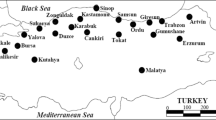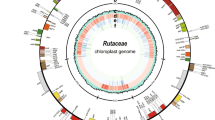Abstract
Genetic variation inPhaseolus lunatus (Lima bean) was investigated at isozyme and DNA levels. Sixty cultivated accessions, including representatives of the Mesoamerican and Andean gene pools and intermediate types, were analyzed for variability at 17 isozyme loci. Some accessions were also examined for restriction fragment length polymorphism (RFLP) at the rDNA level. These data were used to construct two dendrograms showing clear separation in two distinct groups corresponding to each of the gene pools and an intermediate one probably representing a transitional group.
Similar content being viewed by others
References
Becerra Velasquez, V., Gepts, P., 1994: RFLP diversity of common bean (Phaseolus vulgaris) in its centres of origin. — Genome37: 256–263.
Dellaporta, S. L., Wood, J., Hicks, J. B., 1983: A plant DNA minipreparation: version II. — Pl. Molec. Biol. Reporter.1: 19–21.
Freyre, R., Rios, R., Guzman, L., Debouck, D. G., Gepts, P., 1996: Ecogeographic distribution ofPhaseolus spp. (Fabaceae) in Bolivia. — Econ. Bot.50: 195–215.
Garvin, D. F., Roose, M. L., Waines, J. G., 1989: Isozyme genetics and linkage in tepary bean,Phaseolus acutifolius A. Gray. — J. Heredity80: 373–376.
—, 1990: Aconitase variation in tepary bean suggests a common origin for domesticated landraces. — Report (Annual) Bean Improv. Coop.33: 132–133.
Gepts, P., Osborn, T. C., Rashka, K., Bliss, F. A., 1986: Phaseolin protein variability in wild forms and landraces of common bean (Phaseolus vulgaris): evidence for multiple centers of domestication. — Econ. Bot.40: 451–468.
Gerlach, W. L., Bedbrook, J. R., 1989: Cloning and characterization of ribosomal RNA genes from wheat and barley. — Nucl. Acids Res.7: 1869–1885.
Gutierrez Salgado, A., Gepts, P., Debouck, D. G., 1995: Evidence for two gene pools of the Lima bean,Phaseolus lunatus L., in the Americas. — Genet. Res. Crop Evol.42: 15–28.
Hussain, A., Bushuk, W., Ramirez, H., Roca, W., 1988: A practical guide for electrophoretic analysis of isoenzymes and proteins in cassava, field beans and forage legumes. — Working document no.40 Centro International de Agricultura Tropical (CIAT), Cali, Colombia.
Jaaska, V., 1996: Isoenzyme diversity and phylogenetic affinities among thePhaseolus beans (Fabaceae). — Pl. Syst. Evol.200: 233–252.
Jacob, M., Zink, D., Nagl, W., 1995: RFLPs of the rDNA genes in the genusPhaseolus. — Genet. Res. Crop Evol.42: 97–106.
Kaplan, L., Kaplan, N., 1988:Phaseolus in archaeology. — InGepts, P., (Ed.): Genetic resources ofPhaseolus beans, pp. 125–142. — Dordrecht: Kluwer.
Koenig, R., Gepts, P., 1989: Allozyme diversity in wildPhaseolus vulgaris: further evidence for two major centers of diversity. — Theor. Appl. Genet.78: 809–817.
Leitch, A. R., Heslop-Harrison, J. S., 1993: Ribosomal RNA gene expression and localization in cereals. — InSumner, A. T., Chandley, A. C., (Eds): Chromosomes today11, pp. 91–100. — London: Chapmann & Hall.
Lioi, L., 1994: Morphotype relationships in Lima bean (Phaseolus lunatus L.) deduced from variation of the evolutionary marker phaseolin. — Genet. Res. Crop Evol.41: 81–85.
—, 1996: Phaseolin diversity in wild Lima bean (Phaseolus lunatus L.) in American centres of origin. — Genet. Res. Crop Evol.43: 575–580.
Mackie, W. W., 1943: Origin, dispersal and variability of the Lima bean,Phaseolus lunatus. — Hilgardia15: 1–24.
Maggini, F., Tucci, G., Demartis, A., Gelati, M. T., Avanzi, S., 1992: Ribosomal RNA genes ofPhaseolus coccineus I. — Pl. Molec. Biol.18: 1073–1082.
Maquet, A., Gutierrez, A., Debouck, D. G., 1990: Further biochemical evidence for the existence of two gene pools in Lima beans. — Report (Annual) Bean Improv. Coop.33: 128–129.
—, 1996: Case studies on breeding systems and its consequences for germplasm conservation. 1. Isozyme diversity in wild Lima bean populations in central Costa Rica. — Genet. Res. Crop Evol.43: 309–318.
Müeller-Starck, G., 1997: Isozymes. — InKarp, A., Isaac, P. G., Ingram, D. S., (Eds): Molecular tools for screening biodiversity: plants and animals. — London: Chapmann & Hall.
Nei, M., 1978: Estimation of average heterozygosity and genetic diversity in subdivided population. — Genetics89: 583–590.
Nienhuis, J., Tivang, J., Skroch, P., Dos Santos, J. B., 1995: Genetic relationships among cultivars and landraces of Lima bean (Phaseolus lunatus L.) as measured by RAPD markers. — J. Amer. Soc. Hort. Sci.120: 300–306.
Panella, L., Gepts, P., 1992: Genetic relationships withinVigna unguiculata (L.)Walp. based on isozyme analyses. — Genet. Res. Crop Evol.39: 71–88.
Schinkel, C., Gepts, P., 1989: Allozyme variability in the tepary bean,Phaseolus acutifolius A. Gray. — Pl. Breed.102: 182–195.
Sparvoli, F., Daminati, M. G., Lioi, L., Bollini, R., 1996: In vivo endoproteolytically cleaved phaseolin is stable and accumulates in developingPhaseolus lunatus seeds. — Biochim. Biophys. Acta1292: 15–22.
Sprecher, S. L., 1988: New isozyme variants at two NADH diaphorase loci in dry beans: correlations to gene pools and commercial classes. — Report (Annual) Bean Improv. Coop.31: 92.
Weeden, N. F., 1984: Linkage between the gene coding the small subunit of ribulose bisphosphate carboxylase and the gene coding malic enzyme inPhaseolus vulgaris. — Report (Annual) Bean Improv. Coop.27: 123–124.
—, 1986: Genetic confirmation that the variation in the zymograms of 3 enzyme systems is produced by allelic polymorphism. — Report (Annual) Bean Improv. Coop.29: 117–118.
Zink, D., Schumann, K., Nagl, W., 1994: Restriction fragment length polymorphysms of the phytohemagglutinin genes inPhaseolus andVigna (Leguminosae). — Pl. Syst. Evol.191: 131–146.
Author information
Authors and Affiliations
Corresponding author
Rights and permissions
About this article
Cite this article
Lioi, L., Lotti, C. & Galasso, I. Isozyme diversity, RFLP of the rDNA and phylogenetic affinities among cultivated Lima beans,Phaseolus lunatus (Fabaceae). Pl Syst Evol 213, 153–164 (1998). https://doi.org/10.1007/BF00985196
Received:
Revised:
Accepted:
Issue Date:
DOI: https://doi.org/10.1007/BF00985196




